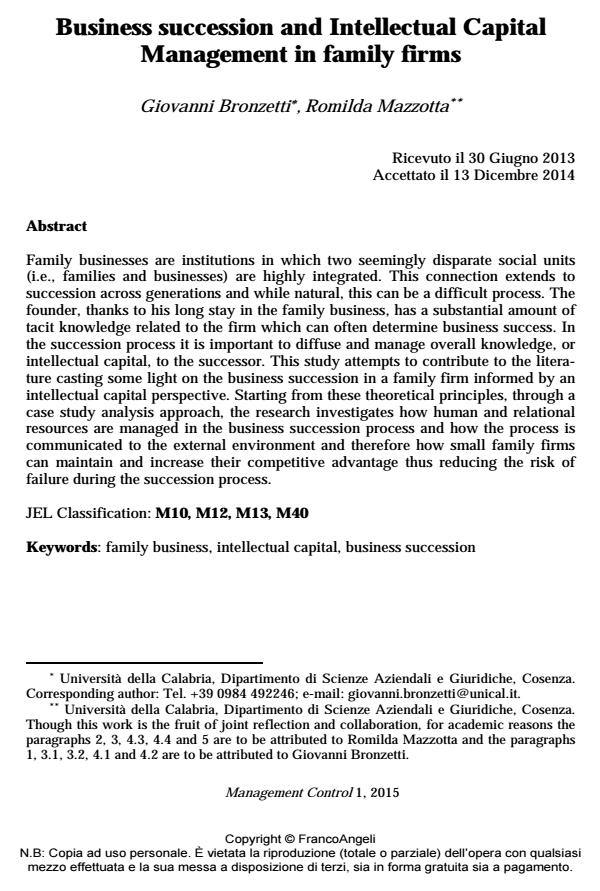Business succession and Intellectual Capital Management in family firms
Titolo Rivista MANAGEMENT CONTROL
Autori/Curatori Giovanni Bronzetti, Romilda Mazzotta
Anno di pubblicazione 2015 Fascicolo 2015/1
Lingua Inglese Numero pagine 28 P. 45-72 Dimensione file 176 KB
DOI 10.3280/MACO2015-001003
Il DOI è il codice a barre della proprietà intellettuale: per saperne di più
clicca qui
Qui sotto puoi vedere in anteprima la prima pagina di questo articolo.
Se questo articolo ti interessa, lo puoi acquistare (e scaricare in formato pdf) seguendo le facili indicazioni per acquistare il download credit. Acquista Download Credits per scaricare questo Articolo in formato PDF

FrancoAngeli è membro della Publishers International Linking Association, Inc (PILA)associazione indipendente e non profit per facilitare (attraverso i servizi tecnologici implementati da CrossRef.org) l’accesso degli studiosi ai contenuti digitali nelle pubblicazioni professionali e scientifiche
Family businesses are institutions in which two seemingly disparate social units (i.e., families and businesses) are highly integrated. This connection extends to succession across generations and while natural, this can be a difficult process. The founder, thanks to his long stay in the family business, has a substantial amount of tacit knowledge related to the firm which can often determine business success. In the succession process it is important to diffuse and manage overall knowledge, or intellectual capital, to the successor. This study attempts to contribute to the literature casting some light on the business succession in a family firm informed by an intellectual capital perspective. Starting from these theoretical principles, through a case study analysis approach, the research investigates how human and relational resources are managed in the business succession process and how the process is communicated to the external environment and therefore how small family firms can maintain and increase their competitive advantage thus reducing the risk of failure during the succession process.
Parole chiave:Family business, intellectual capital, business succession
Jel codes:M10, M12, M13, M40
- Professionalization in Family Businesses. How to strengthen strategy implementation and control, favouring succession Francesca Culasso, Elisa Giacosa, Luca Maria Manzi, Leo-Paul Dana, in MANAGEMENT CONTROL 1/2018 pp.45
DOI: 10.3280/MACO2018-001003 - Strategic performance management systems in Italian banks. A research note Francesca Francioli, in MANAGEMENT CONTROL 2/2018 pp.155
DOI: 10.3280/MACO2018-002008 - The usefulness of accounting information for decision-making purposes in an Italian company from the late nineteenth to the early twentieth century Stefania Veltri, Romilda Mazzotta, Vittorio Palermo, in CONTABILITÀ E CULTURA AZIENDALE 2/2023 pp.29
DOI: 10.3280/CCA2022-002003 - Il ruolo degli spin-off universitari nel contesto socio-economico locale: analisi degli indicatori di performance e innovazione Christian Corsi, in MANAGEMENT CONTROL 1/2018 pp.73
DOI: 10.3280/MACO2018-001004 - Performance-based funding e sistemi di allocazione delle risorse ai dipartimenti: prime evidenze nelle università italiane Andrea Francesconi, Enrico Guarini, in MANAGEMENT CONTROL 1/2017 pp.113
DOI: 10.3280/MACO2017-001006 - High Performance Through Innovation Process Management in SMEs. Evidence from the Italian wine sector Simona Alfiero, Laura Broccardo, Massimo Cane, Alfredo Esposito, in MANAGEMENT CONTROL 3/2018 pp.87
DOI: 10.3280/MACO2018-003005
Giovanni Bronzetti, Romilda Mazzotta, Business succession and Intellectual Capital Management in family firms in "MANAGEMENT CONTROL" 1/2015, pp 45-72, DOI: 10.3280/MACO2015-001003